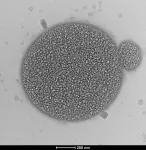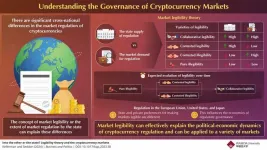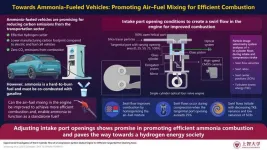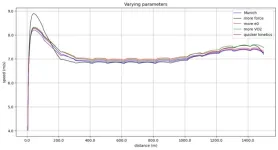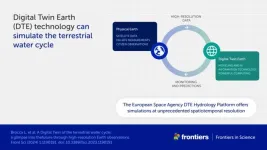(Press-News.org) In the Japanese art of Kintsugi, an artist takes the broken shards of a bowl and fuses them back together with gold to make a final product more beautiful than the original.
That idea is inspiring a new approach to managing plasma, the super-hot state of matter, for use as a power source. Scientists are using the imperfections in magnetic fields that confine a reaction to improve and enhance the plasma in an approach outlined in a new paper in the journal Nature Communications.
“This approach allows you to maintain a high-performance plasma, controlling instabilities in the core and the edge of the plasma simultaneously. That simultaneous control is particularly important and difficult to do. That’s what makes this work special,” said Joseph Snipes of the U.S. Department of Energy’s (DOE) Princeton Plasma Physics Laboratory (PPPL). He is PPPL’s deputy head of the Tokamak Experimental Science Department and was a co-author of the paper.
PPPL Physicist Seong-Moo Yang led the research team, which spans various institutions in the U.S. and South Korea. Yang says this is the first time any research team has validated a systematic approach to tailoring magnetic field imperfections to make the plasma suitable for use as a power source. These magnetic field imperfections are known as error fields.
“Our novel method identifies optimal error field corrections, enhancing plasma stability,” Yang said. “This method was proven to enhance plasma stability under different plasma conditions, for example, when the plasma was under conditions of high and low magnetic confinement.”
Errors that are hard to correct
Error fields are typically caused by minuscule defects in the magnetic coils of the device that holds the plasma, which is called a tokamak. Until now, error fields were only seen as a nuisance because even a very small error field could cause a plasma disruption that halts fusion reactions and can damage the walls of a fusion vessel. Consequently, fusion researchers have spent considerable time and effort meticulously finding ways to correct error fields.
“It’s quite difficult to eliminate existing error fields, so instead of fixing these coil irregularities, we can apply additional magnetic fields surrounding the fusion vessel in a process known as error field correction,” Yang said.
In the past, this approach would have also hurt the plasma’s core, making the plasma unsuitable for fusion power generation. This time, the researchers were able to eliminate instabilities at the edge of the plasma and maintain the stability of the core. The research is a prime example of how PPPL researchers are bridging the gap between today’s fusion technology and what will be needed to bring fusion power to the electrical grid.
“This is actually a very effective way of breaking the symmetry of the system, so humans can intentionally degrade the confinement. It’s like making a very tiny hole in a balloon so that it will not explode,” said SangKyeun Kim, a staff research scientist at PPPL and paper co-author. Just as air would leak out of a small hole in a balloon, a tiny quantity of plasma leaks out of the error field, which helps to maintain its overall stability.
Managing the core and the edge of the plasma simultaneously
One of the toughest parts of managing a fusion reaction is getting both the core and the edge of the plasma to behave at the same time. There are ideal zones for the temperature and density of the plasma in both regions, and hitting those targets while eliminating instabilities is tough.
This study demonstrates that adjusting the error fields can simultaneously stabilize both the core and the edge of the plasma. By carefully controlling the magnetic fields produced by the tokamak’s coils, the researchers could suppress edge instabilities, also known as edge localized modes (ELMs), without causing disruptions or a substantial loss of confinement.
“We are trying to protect the device,” said PPPL Staff Research Physicist Qiming Hu, an author of the paper.
Extending the research beyond KSTAR
The research was conducted using the KSTAR tokamak in South Korea, which stands out for its ability to adjust its magnetic error field configuration with great flexibility. This capability is crucial for experimenting with different error field configurations to find the most effective ones for stabilizing the plasma.
The researchers say their approach has significant implications for the design of future tokamak fusion pilot plants, potentially making them more efficient and reliable. They are currently working on an artificial intelligence (AI) version of their control system to make it more efficient.
“These models are fairly complex; they take a bit of time to calculate. But when you want to do something in a real-time control system, you can only afford a few milliseconds to do a calculation,” said Snipes. “Using AI, you can basically teach the system what to expect and be able to use that artificial intelligence to predict ahead of time what will be necessary to control the plasma and how to implement it in real-time.”
While their new paper highlights work done using KSTAR’s internal magnetic coils, Hu suggests future research with magnetic coils outside of the fusion vessel would be valuable because the fusion community is moving away from the idea of housing such coils inside the vacuum-sealed vessel due to the potential destruction of such components from the extreme heat of the plasma.
Researchers from the Korea Institute of Fusion Energy (KFE), Columbia University, and Seoul National University were also integral to the project.
The research was supported by: the U.S. Department of Energy under contract number DE-AC02-09CH11466; the Ministry of Science and ICT under the KFE R&D Program “KSTAR Experimental Collaboration and Fusion Plasma Research (KFE-EN2401-15)”; the National Research Foundation (NRF) grant No. RS-2023-00281272 funded through the Korean Ministry of Science, Information and Communication Technology and the New Faculty Startup Fund from Seoul National University; the NRF under grants No. 2019R1F1A1057545 and No. 2022R1F1A1073863; the National R&D Program through the NRF funded by the Ministry of Science & ICT (NRF-2019R1A2C1010757).
END
One way to improve a fusion reaction: Use weaknesses as strengths
Scientists take advantage of imperfections in magnetic fields to enhance fusion plasma
2024-03-05
ELSE PRESS RELEASES FROM THIS DATE:
Predicting who will experience aesthetic chills
2024-03-05
Researchers built a model that can predict with 73.5% accuracy when a person will experience aesthetic chills: shivers, goosebumps, or a feeling of cold down the neck or spine elicited by aesthetic stimuli, such as beautiful music or an inspirational speech. Felix Schoeller and colleagues surveyed 2,937 people from Southern California, through an online platform, gathering data on their personalities, demographic backgrounds, and emotional state. The authors then exposed survey respondents to 40 emotion-evoking audiovisual clips sourced from social media, selected because commenters had reported experiencing aesthetic chills while watching and listening. ...
Possible ‘Trojan Horse’ found for treating stubborn bacterial infections
2024-03-05
PULLMAN, Wash. – Bacteria can be tricked into sending death signals to stop the growth of their slimy, protective homes that lead to deadly infections, a new study demonstrates.
The discovery by Washington State University researchers could someday be harnessed as an alternative to antibiotics for treating difficult infections. Reporting in the journal, Biofilm, the researchers used the messengers, which they named death extracellular vesicles (D-EVs), to reduce growth of the bacterial communities by up to 99.99% in laboratory experiments.
“Adding the death extracellular vesicles to ...
AI art and human creativity
2024-03-05
Text-to-image generative AI systems like Midjourney, Stable Diffusion, and DALL-E can produce images based on text prompts that, had they been produced by humans, would plausibly be judged as “creative.” Some artists have argued that these programs are a threat to human creativity. If AI comes to be relied on to produce most new visual works, drawing on what has been done before, creative progress could stagnate. Eric Zhou and Dokyun “DK” Lee investigated the impact of text-to-image AI tools on human creativity, seeking to understand ...
Decoding cryptocurrency regulation in the legibility framework
2024-03-05
Since its introduction, cryptocurrency governance has been one of the most controversial global financial topics. While some countries have established elaborate regulations for cryptocurrencies, many countries are still reluctant to oversee the markets, and some have outright banned them. Most studies suggest that public agencies naturally want to regulate markets and bring them into their purview. However, the significant differences in cryptocurrency regulation over the world call this view into question. Moreover, these differences cannot be explained by the development ...
Ammonia-powered engines: A path to cleaner and more efficient transportation
2024-03-05
While the transportation sector has witnessed a dramatic shift toward electric vehicles (EVs), the idea of using hydrogen as a clean and efficient fuel for transportation has been explored for many decades. These vehicles emit water on combustion, and since they are based on the production of existing engine vehicles, they are expected to have a lower manufacturing carbon footprint than EVs. However, storing and transporting hydrogen requires high pressures and low temperatures, which are energy-intensive processes. To address this, ammonia has ...
Running performance helped by mathematical research
2024-03-05
How to optimise running? A new mathematical model1 has shown, with great precision, the impact that physiological and psychological parameters have on running performance and provides tips for optimised training. The model grew out of research conducted by a French-British team including two CNRS researchers2, the results of which will appear on March 5th 2024 in the journal Frontiers in Sports and Active Living.
This innovative model was developed thanks to extremely precise data3 from the performances of Matthew Hudson-Smith (400m), Femke Bol (400m), and ...
New ‘digital twin’ Earth technology could help predict water-based natural disasters before they strike
2024-03-05
The water cycle looks simple in theory — but human impacts, climate change, and complicated geography mean that in practice, floods and droughts remain hard to predict. To model water on Earth, you need incredibly high-resolution data across an immense expanse, and you need modeling sophisticated enough to account for everything from snowcaps on mountains to soil moisture in valleys. Now, scientists funded by the European Space Agency have made a tremendous step forward by building the most detailed models created to date.
“Simulating ...
Sweetened drinks linked to atrial fibrillation risk
2024-03-05
Research Highlights:
An analysis of health data in the UK Biobank found a 20% higher risk of irregular heart rhythm, known as atrial fibrillation, among people who said they drank two liters or more per week (about 67 ounces) of artificially sweetened drinks. The risk was 10% higher among people who said they drank similar amounts of sugar-sweetened beverages.
Drinking one liter (about 34 ounces) or less of pure juice per week, such as 100% orange or vegetable juice, was associated with an 8% lower risk of atrial fibrillation.
The observational study could not confirm that sweetened drinks cause irregular heart rhythms.
Embargoed ...
Hazardous heat and humidity is widespread in US jails and prisons, and climate change is worsening conditions
2024-03-05
An estimated 1.8 million incarcerated people in the United States have been recently exposed to a dangerous combination of heat and humidity, and on average experience 100 days of these conditions each year—many of them in the 44 states that do not provide universal air conditioning to inmates. Tracking with climate change, in recent decades, the number of dangerous humid heat days in carceral facilities has increased, with those in the south experiencing the most rapid warming.
The findings by researchers at Columbia University Mailman School of Public Health, Montana State University, ...
8 in 10 lizards could be at risk due to deforestation
2024-03-05
In Colorado, people flock to the Rocky Mountains when the summer heat gets unbearable. Animals seek shelter too when temperatures become extreme, and forests serve as critical sanctuaries for small tree-dwelling animals like lizards.
In a new study published March 5 in the journal Nature Climate Change, scientists from the University of Colorado Boulder and Tel Aviv University in Israel revealed that deforestation combined with climate change could negatively impact 84% of North America’s lizards by ...
LAST 30 PRESS RELEASES:
Young adults commonly mix cannabis with nicotine and tobacco
Comprehensive review illuminates tau protein's dual nature in brain health, disease, and emerging psychiatric connections
Book prepares K-12 leaders for the next public health crisis
Storms in the Southern Ocean mitigates global warming
Seals on the move: Research reveals key data for offshore development and international ecology
Sports injuries sustained during your period might be more severe
World's first successful 2 Tbit/s free-space optical communication using small optical terminals mountable on satellites and HAPS
Can intimate relationships affect your heart? New study says ‘yes’
Scalable and healable gradient textiles for multi‑scenario radiative cooling via bicomponent blow spinning
Research shows informed traders never let a good climate crisis go to waste
Intelligent XGBoost framework enhances asphalt pavement skid resistance assessment
Dual-function biomaterials for postoperative osteosarcoma: Tumor suppression and bone regeneration
New framework reveals where transport emissions concentrate in Singapore
NTP-enhanced lattice oxygen activation in Ce-Co catalysts for low-temperature soot combustion
Synergistic interface engineering in Cu-Zn-Ce catalysts for efficient CO2 hydrogenation to methanol
COVID-19 leaves a lasting mark on the human brain
Scientists use ultrasound to soften and treat cancer tumors without damaging healthy tissue
Community swimming program for Black youth boosts skills, sense of belonging, study finds
Specific depressive symptoms in midlife linked to increased dementia risk
An ‘illuminating’ design sheds light on cholesterol
Who is more likely to get long COVID?
Study showcases resilience and rapid growth of “living rocks”
Naval Research Lab diver earns Office of Naval Research 2025 Sailor of the Year
New Mayo-led study establishes practical definition for rapidly progressive dementia
Fossil fuel industry’s “climate false solutions” reinforce its power and aggravate environmental injustice
Researchers reveal bias in a widely used measure of algorithm performance
Alcohol causes cancer. A study from IOCB Prague confirms damage to DNA and shows how cells defend against it
Hidden viruses in wastewater treatment may shape public health risks, study finds
Unlock the power of nature: how biomass can transform climate mitigation
Biochar reshapes hidden soil microbes that capture carbon dioxide in farmland
[Press-News.org] One way to improve a fusion reaction: Use weaknesses as strengthsScientists take advantage of imperfections in magnetic fields to enhance fusion plasma
